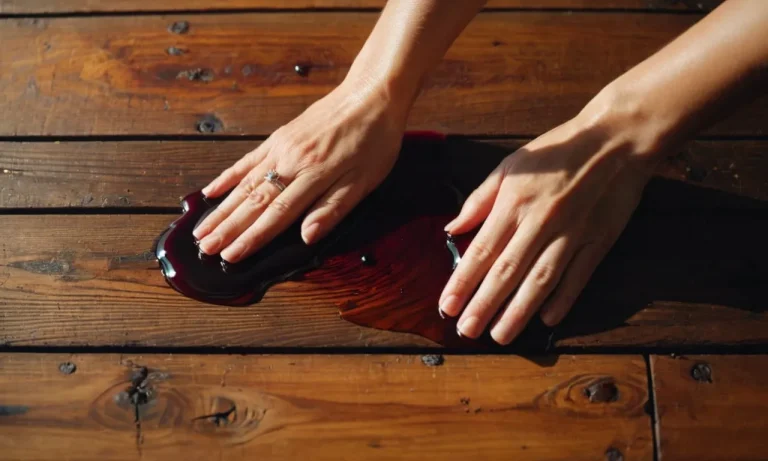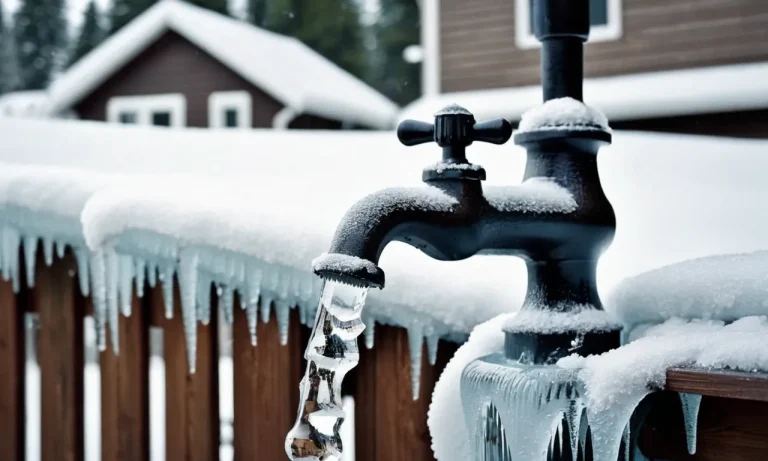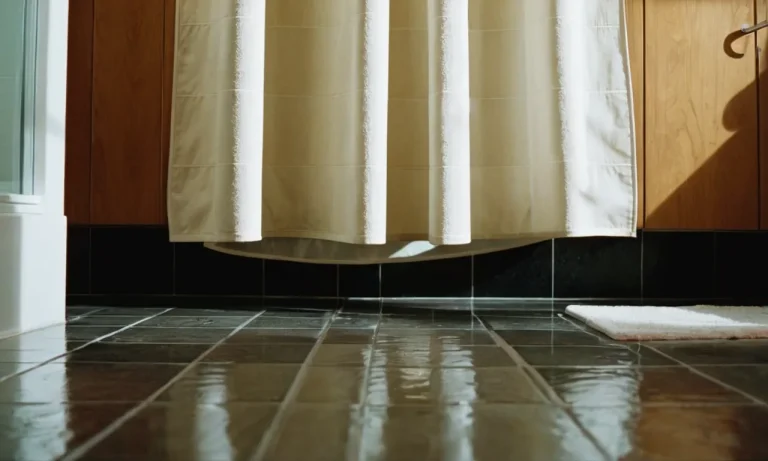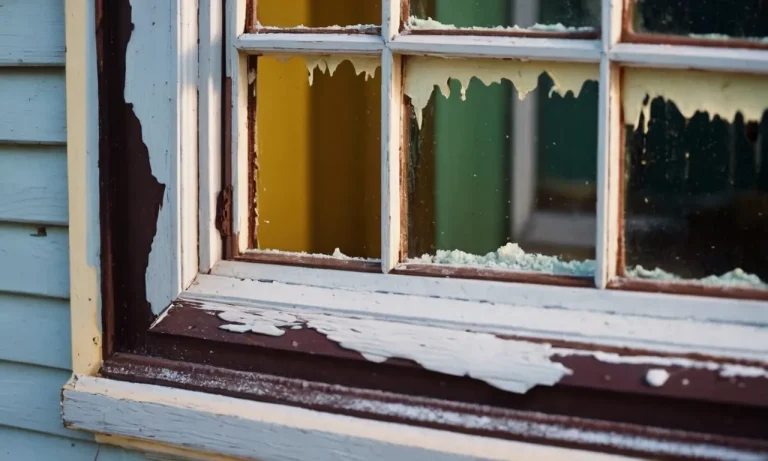How To Remove Calcium Buildup On Faucets
If you notice white, chalky deposits on your bathroom or kitchen faucet, you’re not alone. Hard water is the culprit behind calcium buildup on faucets, and it can be a real pain to remove if left too long.
If you’re short on time, here’s a quick answer to your question: Calcium deposits on faucets can be removed with white vinegar or a calcium-lime-rust remover product. Let it soak on the deposits for a few hours before scrubbing.
Prevent future buildup by installing a water softener or filtering system.
In this comprehensive guide, we’ll cover everything you need to know about calcium buildup on faucets, from what causes it to develop in the first place to tips for removal and prevention.
What Causes Calcium Buildup on Faucets?
Calcium buildup on faucets is a common issue that many homeowners face. Understanding the causes of this buildup can help you prevent it and keep your faucets clean and functioning properly.
Hard Water
One of the main culprits behind calcium buildup on faucets is hard water. Hard water is water that contains a high concentration of minerals, such as calcium and magnesium. When hard water flows through your faucets, these minerals can accumulate over time, leaving behind a white, chalky residue.
Hard water is a widespread problem in many areas. According to a study conducted by the United States Geological Survey, over 85% of homes in the country have hard water. The minerals in hard water not only cause unsightly buildup on faucets but can also affect the performance and lifespan of appliances like dishwashers and water heaters.
To combat this issue, you may want to consider installing a water softener in your home. A water softener can help remove the excess minerals from your water, reducing the likelihood of calcium buildup on your faucets.
Faucet Materials
The materials used in your faucets can also contribute to calcium buildup. Some faucet materials, such as chrome and stainless steel, are more prone to showing water spots and mineral deposits. These materials can create a breeding ground for calcium buildup, especially in areas with hard water.
If you’re experiencing frequent calcium buildup on your faucets, you may want to consider switching to faucets made from materials that are less prone to showing water spots. Options like brushed nickel or oil-rubbed bronze can be more resistant to calcium buildup and require less frequent cleaning.
Regular cleaning and maintenance are also essential to prevent calcium buildup on faucets, regardless of the materials used. Using a mild, non-abrasive cleaner and a soft cloth, gently scrub your faucets regularly to remove any mineral deposits and keep them looking sparkling clean.
Remember, prevention is key when it comes to dealing with calcium buildup on faucets. By understanding the causes and taking proactive measures, you can keep your faucets in great condition and prolong their lifespan.
How to Remove Existing Calcium Deposits
Over time, faucets can develop unsightly calcium buildup that not only looks unappealing but can also affect the water flow. Fortunately, there are several methods you can use to effectively remove these stubborn deposits and restore your faucet’s shine.
Vinegar Soak
One of the most popular and effective ways to remove calcium buildup is by using vinegar. Vinegar is a natural acid that can break down the calcium deposits without causing any harm to your faucet. Simply soak a cloth or sponge in white vinegar and wrap it around the affected area.
Leave it overnight, allowing the vinegar to dissolve the deposits. In the morning, remove the cloth and scrub the faucet with a soft brush. Rinse thoroughly with water and enjoy your sparkling clean faucet!
Calcium-Lime-Rust Remover
If the vinegar soak doesn’t completely remove the calcium deposits, you can try using a calcium-lime-rust (CLR) remover. CLR is a powerful cleaner specifically designed to remove tough mineral deposits.
Apply the CLR to the affected area according to the product instructions and let it sit for a few minutes. Then, scrub the faucet with a brush and rinse well. Be sure to wear gloves and follow all safety precautions when using this product.
Baking Soda Scrub
For a gentler approach, you can use baking soda to remove calcium buildup. Create a paste by mixing baking soda with a small amount of water. Apply the paste to the affected areas of the faucet and let it sit for about 15 minutes. Then, scrub the faucet with a soft brush or cloth.
Rinse thoroughly with water to remove any residue. Baking soda is a mild abrasive that can effectively remove the deposits without scratching the surface of your faucet.
Lemons
Another natural remedy for removing calcium deposits is lemons. Cut a lemon in half and rub it directly onto the affected areas of the faucet. The citric acid in the lemon will help dissolve the calcium deposits. After scrubbing with the lemon, rinse the faucet well with water.
Not only will your faucet be free from calcium buildup, but it will also have a fresh, citrus scent!
Remember, regular maintenance is key to preventing excessive calcium buildup on your faucets. Wipe down your faucets regularly with a soft cloth to remove any water spots and prevent mineral deposits from forming.
By following these tips, you can keep your faucets looking great and functioning properly for years to come!
Preventing Future Calcium Buildup
To prevent future calcium buildup on your faucets, there are several steps you can take:
Install a Water Softener
One of the most effective ways to prevent calcium buildup is by installing a water softener. A water softener works by removing the minerals that cause hardness in the water, such as calcium and magnesium. This can help extend the lifespan of your faucets and other plumbing fixtures.
You can find a variety of water softeners available on the market, so be sure to choose one that suits your needs and budget.
Use a Filter
Another option to prevent calcium buildup is to use a water filter. A water filter can help remove impurities and minerals from the water, including calcium. There are different types of filters available, such as activated carbon filters or reverse osmosis systems.
Research the options and choose one that best fits your needs.
Wipe Faucets After Use
A simple yet effective habit to prevent calcium buildup is to wipe your faucets after each use. This will help remove any water droplets that may contain minerals. Use a soft cloth or towel to gently wipe the faucets, paying attention to areas where water tends to accumulate, such as the aerator.
By doing this, you can reduce the chances of calcium buildup over time.
Avoid Letting Water Evaporate on Faucets
When water evaporates on your faucets, it can leave behind mineral deposits, including calcium. To prevent this, make sure to dry your faucets thoroughly after each use. This will not only help prevent calcium buildup but also keep your faucets looking clean and shiny.
By following these preventative measures, you can keep your faucets free from calcium buildup and maintain their functionality and appearance for years to come.
When to Call a Plumber for Calcium Removal
Removing calcium buildup from faucets can be a challenging task, especially if it has accumulated over a long period of time. While there are several DIY methods that can help you tackle this issue, there are certain situations where calling a plumber is the best course of action.
Here are a few instances when it is recommended to seek professional help:
1. Heavy Buildup
If the calcium buildup on your faucets is extensive and covers a large area, it may be difficult to remove it completely on your own. In such cases, a plumber with specialized tools and expertise can ensure a thorough cleaning, restoring your faucet to its original condition.
2. Stubborn Deposits
Some calcium deposits can be extremely stubborn and resistant to regular cleaning methods. If you have tried multiple DIY solutions and the buildup still persists, it might be time to call in a professional plumber.
They have access to powerful cleaning agents and equipment that can effectively dissolve and remove even the toughest calcium deposits.
3. Plumbing System Inspection
If you notice calcium buildup on your faucets, it could be an indication of a larger problem within your plumbing system. In such cases, a plumber can conduct a thorough inspection to identify the root cause of the issue.
This can help prevent further damage and ensure that your plumbing system is functioning optimally.
4. Time Constraints
Removing calcium buildup can be a time-consuming process, especially if you have multiple faucets affected by the problem. If you have a busy schedule or simply don’t have the time to dedicate to this task, hiring a plumber can save you valuable time and effort.
Remember, while some minor calcium buildup can be easily removed using DIY methods, there are situations where it is best to leave the job to the professionals. By calling a plumber, you can ensure a thorough and efficient removal of calcium buildup, leaving your faucets clean and functioning properly.
Conclusion
Calcium buildup on faucets is a common nuisance caused by hard water, but thankfully it can be removed and prevented with some simple solutions.
By using vinegar, calcium remover products, or baking soda and regularly wiping down your faucets, you can keep them looking shiny and new. For severe buildup, calling a plumber for professional cleaning may be your best bet.
Implementing preventive measures like a water softener or filter will also help reduce calcium deposits over time. With a bit of elbow grease and the right tools, you can conquer calcium buildup and restore the beauty of your faucets.







